|
Supermarine Spitfire
Mk.IIb & Vb (Early)
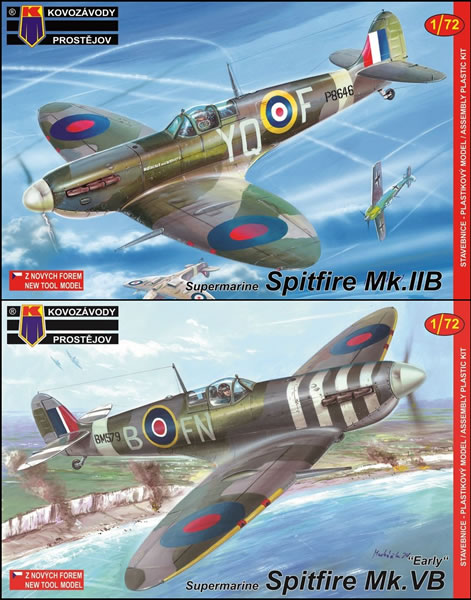
Kovozavody Prostejov, 1/72 scale
S u m m a r y : |
Catalogue Number: |
KPM0056 – Supermarine Spitfire Mk.IIb
KPM0057 – Supermarine Spitfire Mk.Vb “Early” |
Scale: |
1/72 |
Contents & Media: |
Sixty-nine grey and two clear styrene parts, with decals for three markings options in each case. |
Price: |
Available on-line from: |
Stockist |
Mk.IIb |
Mk.Vb |
Kovozavody Prostejov |
€12.99 |
€12.99 |
Hannants |
£8.33 |
£8.33 |
Review Type: |
First Look. |
Advantages: |
Accurate, very good quality, great value, and apparently builds very well. |
Disadvantages: |
None noted. |
Conclusion: |
These are superb kits in every respect. Very accurate, beautifully molded with delicate panel lines, and superb detail; they are in my opinion the best examples of the Spitfire Mk.IIb and Vb in ‘The One True Scale’. Clear and attractive instructions and well printed decals cap things off nicely.
I think these kits are excellent value and I cannot recommend them highly enough. I eagerly await more new tool Spitfire kits from Kovozavody Prostejov. |
Reviewed by Mark Davies

Eduard's 1/72 Avia B.534 IV serie Profipack Edition is available online from Squadron.com
The Spitfire needs no introduction, but for those who wish for a convenient insight to its development just click here.
Some might ask - why do we need another Spitfire kit? My answer is that as long as it improves on what has gone before, or equals it at a lower price, then we as modellers are the winners; although I accept non-Spitfire fans may wish some other subject be kitted instead.
My first impression of Kovozavody Prostejov’s new Spitfires was that they have every possibility of improving on what has gone before. But before deciding if they do I want to cover off a couple of points...
Kovozavody Prostejov is a re-launched brand under the same ownership as AZ Models, Admiral & Legato; and is clearly the flagship of the brand stable. It has no relationship to the communist-era range of kits originally released under the same name, and since sold under several other brand names.
I have read of some concern on forums that these kits are re-issues of AZ Model’s existing early Spitfire kits. Let me dispel that concern straight away. Whilst the parts do appear to share a similar or common design ancestry, be it CAD or physical master, it is clear that we are dealing with a totally new tooling (that is to say, a new mold).
Upon comparing the Kovozavody Prostejov parts to AZ Model’s Mk.II it is immediately apparent that the new kits are not limited-run moldings, but from the same style of metal molds used for other recent Kovozavody Prostejov releases, as well as AZ Model’s Spitfire Mk IX, Bf 109G and others (AZ Models describes these issues as HQ for High Quality). The new tooling includes a different parts layout, tabs on the tailplane, some locating pins, distinctly crisper molding, and other detail differences.
The Contents
Both of the kits reviewed here are essentially the same as they share common sprues. I will therefore refer use the singular “kit” during most of this first look.
In each case the kit comes in an end-opening box with attractive enough artwork on the front and two colour schemes on the rear. The main sprues and decal sheets come in a re-sealable cellophane bag, whilst the clear parts and decals are in a small bag of their own.
The instructions are in colour, printed on glossy paper, and consist of a single folded A4 sheet. There is a brief history of the aircraft, and all text is in both Czech and English. They have a parts map and use easy to follow assembly diagrams with detail colour call-outs. A nice touch is the inset drawings which clarify tailplane and carb-intake fitment, and main landing gear angles.
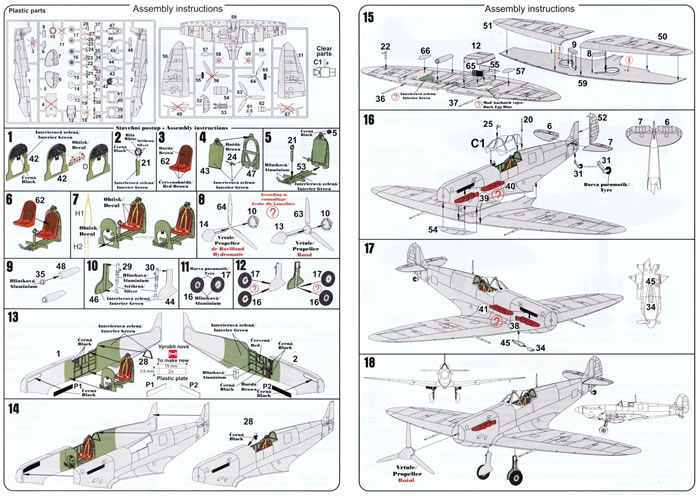
The last page features a colours & markings guide for a third scheme not included on the box’s rear. Colours are cross-referenced to the Humbrol and Agama paint ranges.
Production Quality
Moulded very cleanly with narrow sprue gates; the major airframe parts have very fine surface detail, and the parts breakdown is conventional for the type.
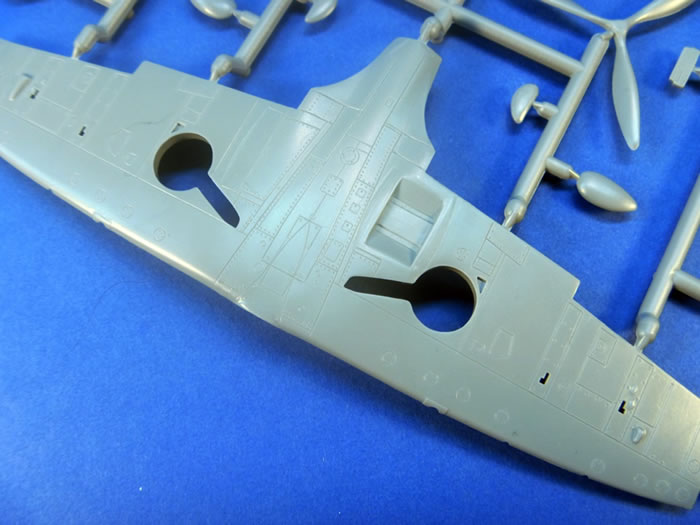
There are a number of small detail parts which are also of very good quality, being clearly defined, albeit a bit softer than the best examples such as Tamiya or Eduard (only really apparent under magnification).
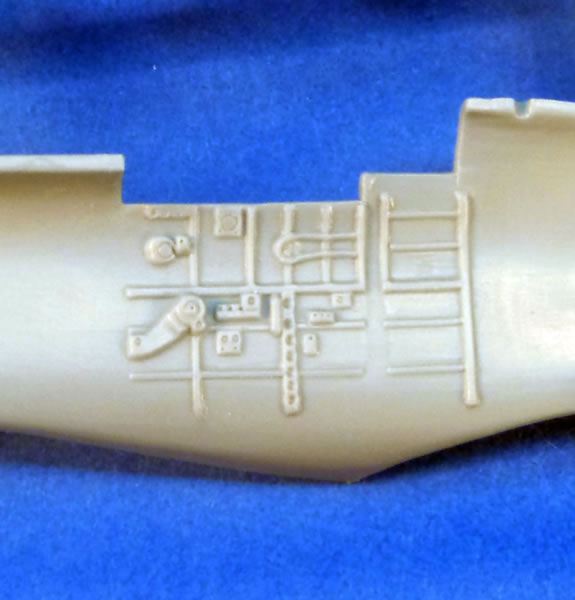
The clear transparency is good and fine for purpose, although again under strong magnification it is not quite as good as the best brands manage; appearing a little rough on the windscreen frames. But to be fair, this is barely noticeable.
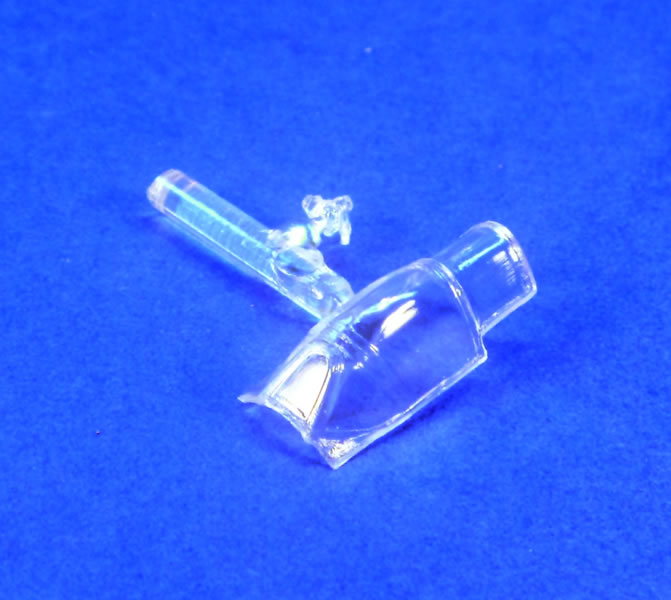
Engineered for Multiple Versions
Unsurprisingly, the kit is engineered to suit a number of versions. It includes a number of options applicable to a Spitfire Mk Ib*, IIb or Vb. These include:
-
Three types of propellers and three spinner styles; metal blade de Havilland and Rotol, plus wooden blade Rotol.
-
Coffman starter bulge.
-
Two styles of antenna poles mast.
-
Two styles of voltage regulator that mount behind the pilot's head armour.
-
Square and round rear-view mirrors.
-
Five-spoke or solid disc main wheels.
-
Two types of oil cooler (Mk.I/II & V).
-
Choice of teardrop or kidney shaped of underwing cannon drum blisters.
-
Choice of triple-ejector exhausts with nozzle or fish-tail outlets.
-
Normal carb-air intake, plus tropical Vokes and Aboukir filters.
-
Wingtip fairing for clipped wings.
-
90 Gallon ventral overload tank.
Possibly the only thing missing is a fabric aileron option, since the kit clearly has metal-skinned examples as evidenced by their rivet detail. This is not wrong as such, because metal-skinned ailerons were introduced early in the Mk.V’s production line in May 1941, and retrofitted to Mk.II’s from around mid-1941 on. In this scale I think filling the delicate rivet detail will suffice for fabric ailerons if required. As far as the six markings choices provided across both kits go, only one is a likely possibility for fabric-covered ailerons (see later).
* I believe that Mk.Ib, although commonly used, is an unofficial designation for cannon-armed Mk.I’s; and that the terms A & B-wing came into official sue with the production of the Mk.IIb. The few remaining cannon-armed Mk.I’s were converted to Mk.Vb’s by the time distinguishing between A, B & C-wings was necessary. Some speculate that the Mk.I cannon installation had different wing bulges to those of the Mk.IIB, but I have found no evidence of this. Spitfire expert, the late Edgar Brooks, declared them both to use the same B-wing (there were two styles of underwing bulge however on Mk.Vb’s).
Accuracy
The kit appears to be extremely accurate based on comparison to the 1978 Airfix Spitfire Mk.Ia, which is universally regarded as an accuracy benchmark for early Spitfires. The major airframe parts align so precisely that they are interchangeable. For those that prefer comparison to plans I can advise that the kit corresponds precisely with A.J. Granger's, which I understand to be well regarded.
The Kit
Starting with the cockpit we find one of the best detailed Spitfire offices I have encountered in ‘The One True Scale’. It features sidewall detail molded integrally with the fuselage halves, air bottles, open-rail floor, main bulkhead, small bulkhead, seat armour, seat adjustment lever, control column, rudder pedals, seat, voltage regulator (two styles), instrument panel, and gun-sight. These items are all nicely detailed and authentic in appearance.
The instrument panel features raised detail, but also has a decal with well printed instrument faces. The pilot’s harness is provided as two decals, again nicely printed. I prefer to cut these out with their backing paper in place, enabling a more 3D effect to be obtained compared to applying them as decals. It is necessary to paint the backing paper to match the harness colour, and once glued in place a wash and dry-brush can provide shadows and highlights.
Assembly appears to be perfectly straightforward and, propellers aside, is clearly guided by the instructions. I have read a Czech build review that found the kit to be very easy to assemble.
The instructions for the both kits indicate fitting the metal-blade Rotol propeller with de Havilland spinner but describe at as a de Havilland, but both also include a separate small errata sheet that overrides the instructions to direct the fitment of the correct Rotol spinner with the metal Rotol propeller. I would check references when deciding which propeller type to use, as the de Havilland propeller can still apply to both marks.

One thing that is a little strange given the kit’s thoroughness and overall quality is the need to cut two plastic backing strips from scrap to seat the exhaust manifold against. This is not an onerous requirement; and the instructions provide dimensions.

The instructions also mention the need to drill out the outer one of two blind holes in each wing underside in order to correctly locate the cannon bulges.
Small features worth mentioning include boxed in wheel wells, separate radiator matrix faces, a separate Mk.V oil-cooler intake ensuring a correctly rounded mouth, plus choices of wheel pattern, rear-view mirror and exhaust styles.
The canopy for both kits has just the early external armoured screen with non- jettisonable hood. However, other boxings I have seen on-line have the later internal armoured screen with the more bulged jettisonable hood as well. A knock-out panel was a feature of the non- jettisonable hood, and the kit has a decal provided to represent this, as it is not molded in the kit’s canopy (probably due to tooling limitations).

There are quite a number of parts left over for the spares box, which any good Spitfire fanatic is sure to appreciate.
Marking Options
The paintings and markings guides are printed as colour 4-view drawings. The plan views are perhaps a little small; but overall, the drawings are quite adequate for their purpose. They include stencil placement as well as main marking positions.
The colour schemes included with the Mk.IIb are:
- P8348 / NS-Y, No 52 OTU, Debden, summer 1943.
- P8346 / RF-T, No 303 (Polish) Sqn, Northolt Summer 1941.
In my opinion, this aircraft might still have had fabric covered ailerons at this time.
Mk.II C&M_1.jpg
- P8646 / YQ-F, No 616 Sqn, Kirton in Lindsey, autumn 1941.
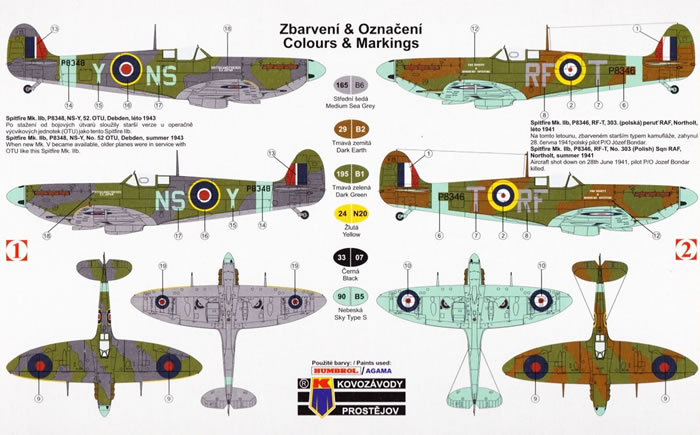
And for the Mk.Vb are:
-
AB790 / AK-J, flown by W/Cdr John A. Kent, Polish Wing, Northolt, July 1941.
-
BL59 / BA-U, No 277 Sqn, late 1944.
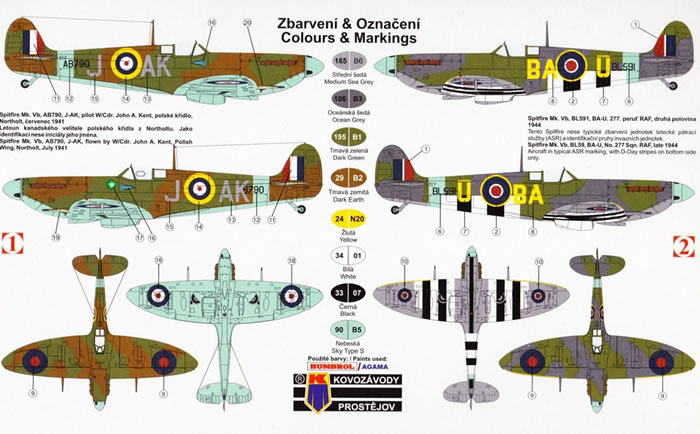
- BM579 / FN-B, No 331 (Norwegian) Sqn, early July 1942.
This option features white ID striping on the cowl and tail, which is often incorrectly associated as being applied for Operation Jubilee, the raid on Dieppe of August 1942 which suggest date conflict. However, the instructions correctly describe these markings as special ID markings of the period (possibly originally applied for the abandoned Operation Rutter).
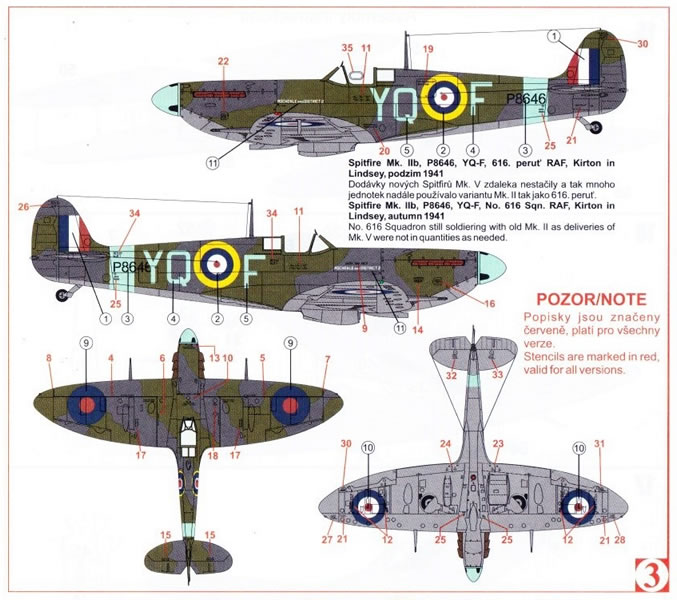
Each kit has two decal sheets, one carrying quite comprehensive stencilling. The decal sheets appear to be extremely well printed in terms of registration etc. I think that some may regard the national insignia’s red and yellow as being a bit too bright, but I can live with this (my scans make the yellow look a little deeper than it appears “in the flesh”).
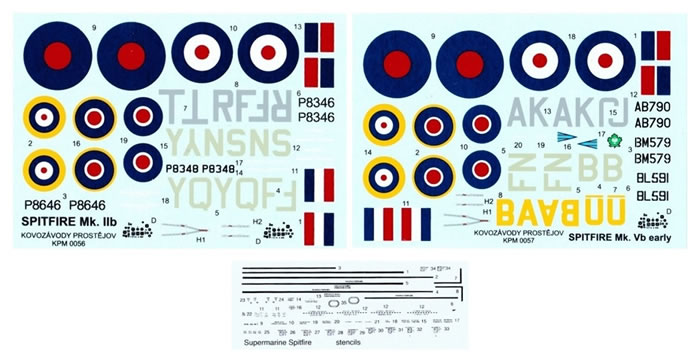
These are superb kits in every respect. Very accurate, beautifully molded with delicate panel lines, and superb detail; they are in my opinion the best examples of the Spitfire Mk.IIb and Vb in ‘The One True Scale’. Clear and attractive instructions and well printed decals cap things off nicely.
I think these kits are excellent value and I cannot recommend them highly enough. I eagerly await more new tool Spitfire kits from Kovozavody Prostejov.
Thanks to Kovozavody Prostejov for the review samples.
Review Text Copyright © 2016 by Mark Davies
Page Created 14 March, 2016
Last updated
15 March, 2016
Back to HyperScale Main Page
Back to Reviews Page |
